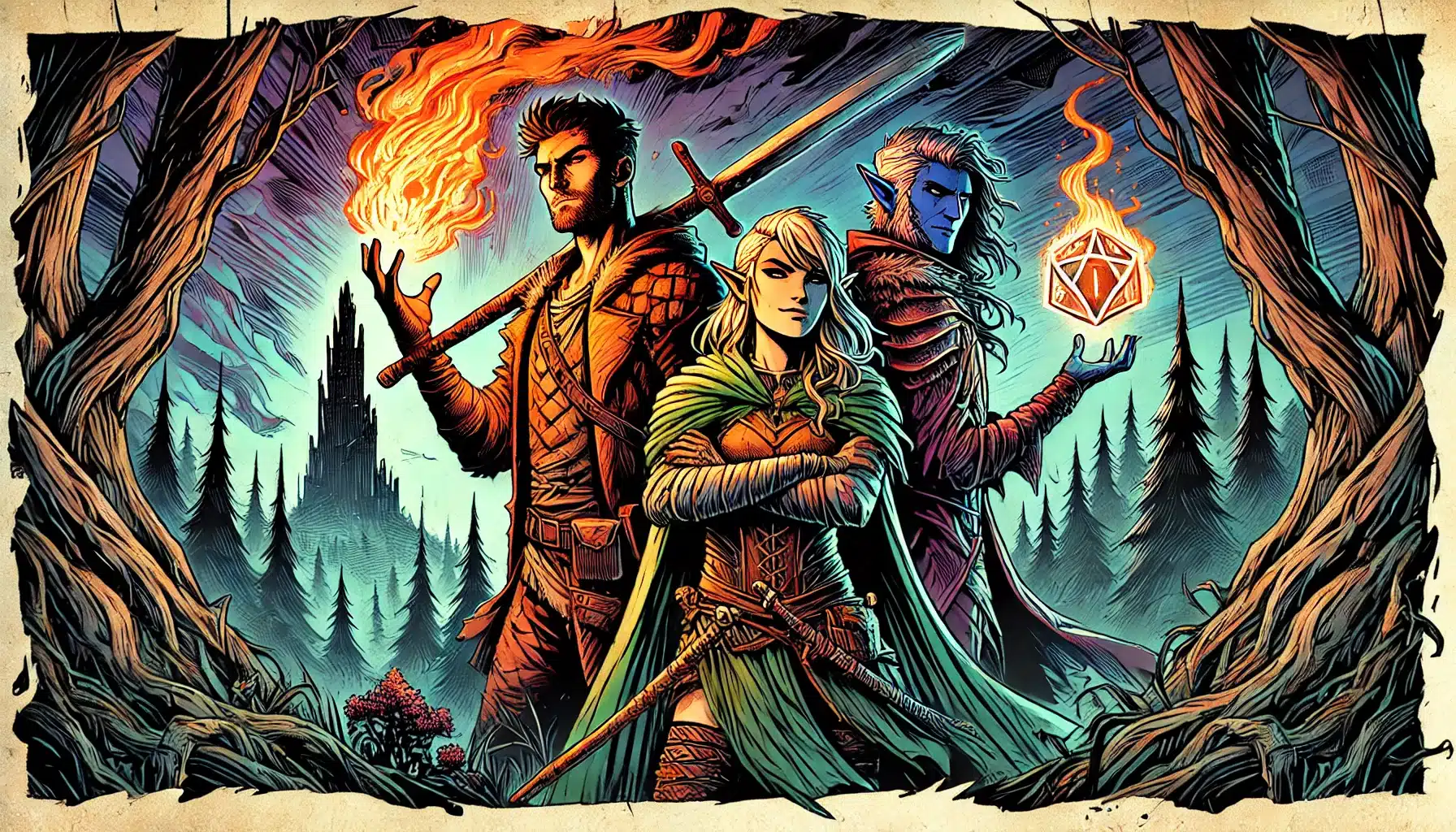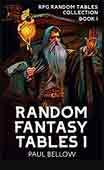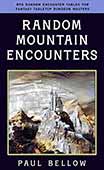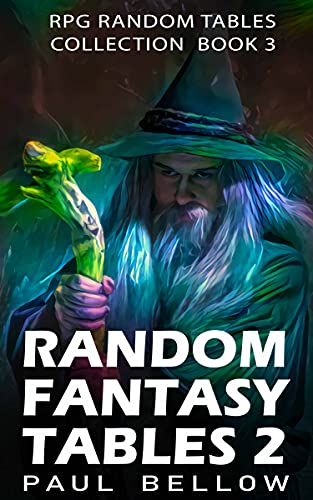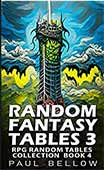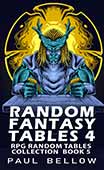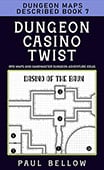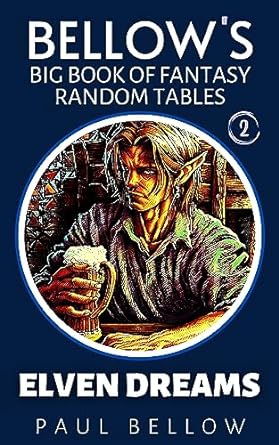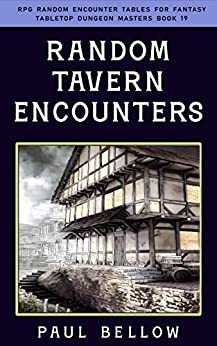Ah, Dungeons & Dragons. This age-old game is not just about rolling dice and fighting dragons. No, it’s about crafting epic adventures with a band of characters as diverse as the sentences in a bestselling novel. You might think, “Hey, let’s just group a few friends together and start playing!” But hold on, there’s a bit more to it. The magic of D&D unfolds when you have a balanced party—a team composed in such a way that they complement one another, like peanut butter and jelly.
Why does party balance matter, you ask? Well, imagine charging into battle with a party full of wizards. Sure, they might put on a dazzling light show, but who’s guarding their squishy selves from a horde of angry goblins? Or picture trudging through ancient ruins without a character savvy in arcane lore. Yikes! The secret sauce in D&D is about striking that perfect balance—combat effectiveness, roleplaying depth, and problem-solving versatility. It’s about digging into the rich narrative of the world without fear of being vanquished at the hands of the first menacing orc you encounter.
When parties are well-rounded, they seamlessly transition from slashing through hordes of orcs to negotiating with a grumpy king or solving the tricky puzzles of a forgotten temple. A balanced party takes on different adventures, effortlessly tackling challenges thrown at them. One moment they’re sneaking into guarded garrisons, the next they’re charming the socks off a dragon. It’s all about adaptability, providing players with the tools they need to conquer whatever crazy curveball the DM lobs their way.
The importance of party balance can’t be overstated. Combat encounters become thrilling when everyone has a chance to shine. The rogue slips into the shadows, the tank takes a shield-rattling hit, the bard strums an enchanting tune, and the wizard unleashes a storm of fire—all working together in harmony. Meanwhile, outside the battlefield, they explore arcane knowledge, broker alliances, or unlock the secrets of a long-lost civilization—all due to the diverse skill set they bring.
Let’s be real: while combat is a big draw of D&D, the real magic lies in the bonds crafted between characters. Party balance isn’t limited to who hits the hardest or knows the most spells. It’s about storytelling. Every character brings a unique perspective, helping to weave a richer tapestry. Balance ensures no one is left in the dark while the rest varnish their character sheets with glory. It’s about fairness and giving everyone a shot at heroics.
Keep this in mind: a campaign flourishes when it’s grounded in teamwork. By considering balance, you create memorable experiences that captivate the heart and invigorate the imagination. Players feed off mutual engagement, creating an unforgettable narrative. A balanced party is like a well-oiled machine, all gears turning seamlessly as they cruise through the storyline with finesse.
Try my AI Tabletop RPG generators...and an extensive library of content!
Are you pumped up yet? You should be! Parties that strike that balance get to enjoy the full smorgasbord of D&D. Whether traversing treacherous terrain, decoding cryptic clues, or battling beastly terrors, it’s all part of the game. Let’s plot out what makes a team well-rounded, and how you can build your own dream team ready to tackle anything. Trust me, your campaign (and your fellow adventurers) will thank you.
- Understanding Party Composition: What Makes a Well-Rounded Team?
- Combat Balance: Ensuring Strength in Battle
- Skill Balance: Covering the Essential Abilities
- Magical vs. Non-Magical Balance: The Arcane Divide
- Party Synergy: Making the Group Work Together
- Aligning Character Backgrounds for Roleplaying Cohesion
- Avoiding Common Pitfalls in Party Building
- Ideal Party Compositions for Different Group Sizes
- Final Thoughts on Party Balance in D&D

Understanding Party Composition: What Makes a Well-Rounded Team?
Alright, adventurers, let’s dive into what it takes to build a team as sturdy and versatile as an all-purpose adventuring Swiss army knife. A truly balanced team has a little bit of everything, ensuring they can tackle any obstacle—be it sharpening swords, or spinning yarns.
First things first: you’ve got your combat roles, right? You need folks in your team who can step up in a fight. Someone to tank those hits, dishing out damage like hotcakes, and keeping foes at arm’s length. But fighting isn’t everything! Consider utility roles—characters who bring invaluable support like buffing allies or debuffing foes. Skills are vital, too. Who’s going to climb that rope, sneak past the guards, or sweet-talk that surly innkeeper?
Next up, we’ve got the skills coverage aspect. A well-rounded party makes sure there’s at least someone trained in every vital skill. Whether it’s handling dangerous negotiations through charisma and wit, or inspecting eldritch runes with bookish insight, skill coverage ensures every challenge presents an opportunity to blitz forward. A crack team thrives on a balance between social butterflies, knowledge seekers, and silent shadows.
⚔️ Fantasy RPG Random Tables Books
Make life as a Gamemaster easier…
If you play Dungeons & Dragons, Pathfinder, or other fantasy RPGs, this
RPG random tables series
is packed with encounters, NPCs, treasure, and more. Available in eBook or print—either way, you’ll have a wealth of adventure ideas at your fingertips.
And here’s the secret sauce: synergy. It’s not just about having a diverse set of skills, but knowing how they blend. Imagine the wombo-combos you can pull off when everybody plays off each other’s strengths! When abilities stack or support each other, your party reaches efficiency levels greater than its parts.
What about the arcane vs. martial debate, you ask? In most campaigns, you’ll face issues that might require the finesse of a rogue or the magical musings of a wizard. A sprinkling of magic peppered amongst physical prowess ensures your party’s toolbox is as broad as the ocean—how else will you handle the shifting sands of myriad challenges that lay ahead?
Ultimately, a well-rounded team thrives on embracing diversity in character roles, crafting a rollercoaster campaign of crescendos and discovery. By knowing what to prepare for, your party is ready—or at least as ready as a bunch of luck-craving adventurers can be! After all, in D&D, it’s about the journey and the triumphs of working together more than the destination itself. So, gather your party, sharpen your swords, and polish your spellbooks, for an epic adventure awaits!
The Four Pillars of Party Balance
Picture a table perfectly balanced on four strong legs. Remove one, and everything crashes down like a house of cards! The same goes for a D&D party. Hold tight to these four pillars: combat, exploration, roleplay, and problem-solving—get them right, and you’re golden.
Combat: Your D&D adventure will involve encounters testing your party’s mettle. Ensuring everyone has a role in battle means that each player gets a moment in the limelight, and nobody falls by the wayside as a battle rages around them.
- Mix of melee and ranged damage dealers.
- Having at least one durable tank.
- Healers for sustainability during long battles.
- Abilities to control enemy movement or battlefield terrain.
Exploration: Want to uncover the treasures of past ages, or uncover foul tragedies long forgotten in shadowed hallways? You need to navigate wilderness and environments expertly.
- Experts in stealth for sneaky missions.
- Perceptive eyes to catch enemy ambushes.
- Survivors that can live off the land.
Roleplay: This is about more than rolling dice—it’s about bringing a character to life and connecting with the other party members.
- Someone comfortable with social encounters.
- Characters who fit naturally into the campaign world.
- Backstories that integrate well with in-game events.
Problem-Solving: Whether decoding puzzles or unmasking conspiracies, critical thinking and creativity go a long way.
- Characters bursting with insight and investigation skills.
- Knowledge in diverse areas—arcane magic, ancient lore, or noble politics.
- Strategic thinkers who can design plans during tough decisions.
A party in tune with these pillars walks smoothly down the dungeon’s dark corridors. They act as a cohesive force, breaking down even the tallest, most ominous, castle door in their path.

Combat Balance: Ensuring Strength in Battle
Battles in D&D, oh what a thrill they can be! Rolling to hit, dodging that fireball, and hoping the dice gods are on your side. Combat might not be the only focus, but a fair share of thrilling showdowns will test every character’s courage and cunning.
In some jaw-dropping campaign moments, the party scrambles to strategize against formidable foes. It’s a theater where every player hopes to strut their stuff, where teamwork polishes their blazing sword until it gleams in the enemy’s terrified gaze. Combat showcases tactical prowess and strength—and it’s fun! When done well, battle brings players together like knights feasting after a victorious triumph.
Here’s where combat balance enters the stage. Striking the right mental cohesion in the battle lineup is key. Ensure every fight feels epic, and the spoils reaped make those harrowing encounters worthwhile. After all, if every player contributes uniquely during combat, there won’t just be victories to recount, but tales of valor that cement camaraderie for campaigns to come.
To begin building your dream team of fighting machines, you must understand the key player roles in a battle. Think of it like assembling a jam band—each instrument, or character, brings something special to the gig. Each role caters to varied styles of combat, enhancing not just individual experiences, but collective glory.
⚔️ Fantasy RPG Random Tables Books
Make life as a Gamemaster easier…
If you play Dungeons & Dragons, Pathfinder, or other fantasy RPGs, this
RPG random tables series
is packed with encounters, NPCs, treasure, and more. Available in eBook or print—either way, you’ll have a wealth of adventure ideas at your fingertips.
The Core Combat Roles in a D&D Party
In the tempest of swords clashing and arrows streaking across the sky, each combat role steps forward to make their mark. To succeed, every combat line-up needs a bit of this and a dash of that—no role left behind.
- Tank (Defender): Often the wall of rock (or stone) between enemies and the softer party members. Tanks are the stalwarts, drawing enemy attention while protecting their squishier allies.
- Striker (Damage Dealer): The one behind those fiery explosive moments, dealing heavy damage and cutting down adversaries with swift, decisive actions. They often run headfirst into trouble, ready to unleash fiery rebukes.
- Support (Healer/Buffer): Healers are the party’s life support, and there when the chips are down. Buffers raise ally spirits and power with those timely boosts that turn the battle tide.
- Controller (Battlefield Manipulator): Influencers of the battlefield, dictating the flow of combat with crowd control and limited enemy options, like grandmasters toying with their encroaching foes.
| Class | Tank Effectiveness | Striker Effectiveness | Support Effectiveness | Controller Effectiveness |
|---|---|---|---|---|
| Fighter | High | Moderate | Low | Moderate |
| Rogue | Low | High | Low | Moderate |
| Cleric | High | Moderate | High | Moderate |
| Wizard | Low | Moderate | Low | High |
| Bard | Low | Moderate | High | Moderate |
| Barbarian | High | Moderate | Low | Moderate |
| Ranger | Moderate | High | Low | Moderate |
| Paladin | High | Moderate | High | Low |
| Druid | Moderate | High | Moderate | High |
| Sorcerer | Low | High | Low | High |
| Warlock | Low | High | Moderate | Moderate |
| Monk | Moderate | High | Low | Moderate |
A party with versatile roles stands steadfast against any foe, ready to meet the next challenge with a shield wall, a flurry of blades, or a well-timed spell.
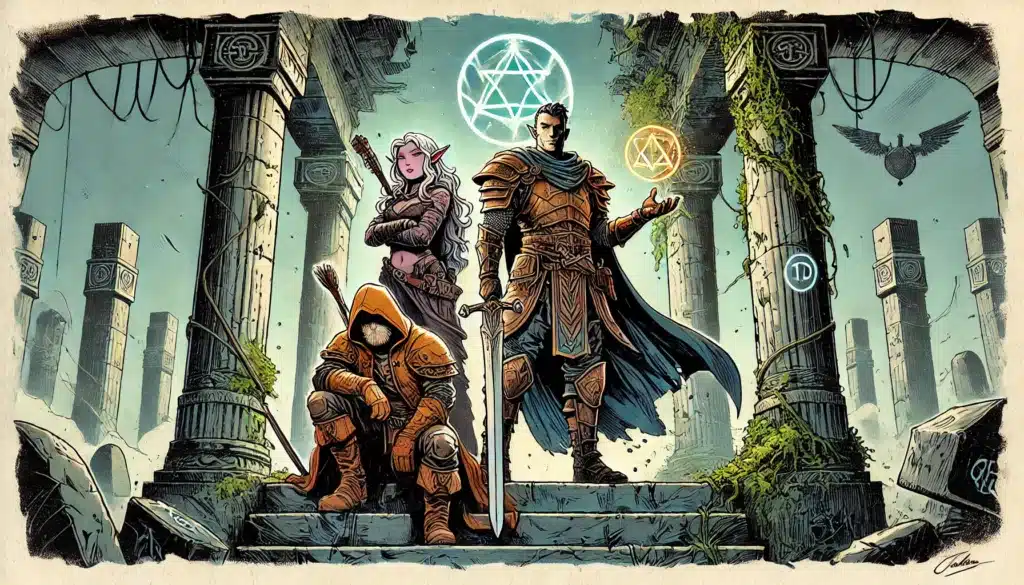
Skill Balance: Covering the Essential Abilities
Beyond the slash-and-thrust of combat, D&D takes adventurers through a world teeming with nuanced situations and quandaries. You might come face to face with a riddle-spouting sphinx or try to haggle down an overpriced magic item. It’s time to flex those mental muscles and hone the skills that guide the intrepid adventurer through dialog tree mazes and history-laden dreams.
Building a party that can handle these scenarios is crucial. Skills influence how groups of players interact with the world outside of the battlefield. Without the right skills, even the mightiest party can feel lost when solving mysteries, navigating societies, or surviving hostile environments. Imagine a group trapped in an enchanted forest with no clear path forward—skills blaze that escape trail.
When exploring dungeons or cities, a broad spectrum of abilities opens doors—sometimes quite literally! From diplomacy marvels to nature gurus, critical skills hold the power to influence narrative arcs—notably how players perceive, interact with, and conquer the game world.
Don’t be that party slogging through mysterious ruins without someone who knows their Arcana from Elementia. Avoid the embarrassment by assembling a crew ready to dig through lore sandboxes brimming with buried secrets.
Essential Skills Every Party Should Have
The list of skills in D&D is vast, but not all skills are created equal when it comes to navigating the tangled web of intrigue, exploration, and adventure. Here’s a breakdown of the must-have skills, categorized to keep your heroic lineup in top form!
Social & Charisma-Based Skills
- Persuasion, Deception, Intimidation: These skills are your bread and butter when you need to cajole, fib, or spook someone into seeing things your way. Confronted by a grumpy duke or a slimy smuggler? Now’s the time to shine.
- Insight: This skill is your litmus test for detection beyond what’s spoken. Knowing when someone’s bluffing can turn the tables faster than you can shout, “Roll initiative!”
Exploration & Survival Skills
- Perception: Critical for noticing danger and spotting hidden traps, treasures, or even an incoming horde—though hopefully not at the same time.
- Stealth: Whether you’re sneaking out of a goblin warren or slipping by the town guards, a good stealth roll is worth its weight in gold.
- Survival & Nature: For wilderness trekking, these skills keep your party from becoming lost or fighting nature’s own traps when traveling.
Knowledge & Utility Skills
- Arcana, Religion, History: Magic-laden worlds mean knowing your stuff. These skills provide insights into magical items, significant religions, or ancient tomes—critical for unlocking plot threads or foiling sinister schemes.
- Investigation: When the devil’s in the details—whether it is following a cryptic map or detecting hidden compartments—investigations are essential for piecing together convoluted puzzles.
- Medicine: The presence of a healer or not, basic medical skills stabilize fallen comrades until help arrives or just past that crooked bridge.
A party equipped with these skills is much like carrying a full toolkit—you have what you need when you need it. Here are 15+ skill distributions to keep your party as prepared as a well-packed adventurer’s backpack:
- Diverse skill coverage among party members.
- Assign multiple characters to crucial skills like Perception and Stealth.
- Use classes or backgrounds that provide skills such as Investigation and Medicine.
- Ensure each player has proficiency in at least one social and one exploration skill.
- Equip at least one character with Arcana to understand magical encounters.
- Train survival experts to weather harsh environments.
- Encourage characters with high charisma for interaction-heavy campaigns.
A party that’s ready for everything will navigate mysteries and avoid unnecessary hiccups as they progress from one fantastical location to another.
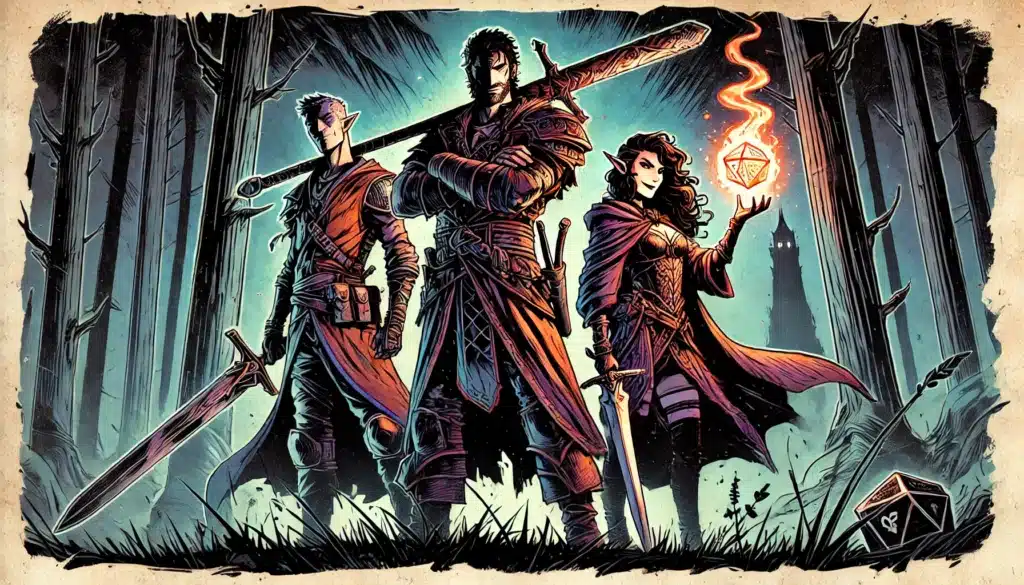
Magical vs. Non-Magical Balance: The Arcane Divide
The essence of Dungeons & Dragons often lies in the mystical dance between the arcane and the mundane. Going head-to-head, spellcasters and martial heroes offer distinct paths to power, each with their own unique skills and quirks. Ever tried solving a magical puzzle with just a greatsword? Or, conversely, attempted to tackle a locked door with a well-placed spell? Consider this: Harmony between magic-users and martial characters opens up worlds of possibilities.
In many campaigns, magic is a canvas painted with imagination—a force altering the playing field like hidden wildcards in a magician’s deck. But physical prowess—wielding swords or bows—poses solutions too, particularly when spells run dry. A team with exposure to both the arcane mysteries and outright brute strength maintains a distinct advantage.
Magic-users, from wizards to sorcerers, bring a flash and flair to any encounter. Whether it’s summoning fireballs or deciphering ancient runes, spellcasters add depth and intrigue, becoming the bridge to esoteric unknowns. On the other hand, martial classes ground parties with steadfast reliability—the unwavering thud of a mace, the precise slice of a dagger.
Each comes with pros and cons. Spellcasters boast explosive potential, but limited spell slots can run dry faster than you can exclaim “Expelliarmus!” Martial characters, meanwhile, emphasize raw strength and resilience, though they lack the flamboyant explosiveness of their arcane teammates.
Finding equilibrium between magic and might is key. Picture your adventurers like a legendary soup—magic can be the rich broth, melding beautifully with the hearty servings of non-magical prowess. You need that gallant fighter or courageous rogue to cut through when grounding malevolence strikes, but don’t forget the seasoned wizard to layer spells in ways that weave wonders and unravel mysteries.
A well-rounded party should equip both dedicated spellcasters and physical fighters. Here’s a glance at the ultimate roster reflecting this harmonious power balance:
| Class | Magical Capabilities | Martial Prowess | Utility & Versatility |
|---|---|---|---|
| Fighter | Low | High | Moderate |
| Rogue | Low | High | High |
| Cleric | High | Moderate | High |
| Wizard | High | Low | High |
| Bard | High | Moderate | High |
| Barbarian | Low | High | Low |
| Ranger | Moderate | High | Moderate |
| Paladin | Moderate | High | High |
| Druid | High | Moderate | High |
| Sorcerer | High | Low | Moderate |
A party that embraces both ends of this magical vs. non-magical spectrum stands strong against anything the campaign world throws at them, from scaling dire dragon peaks to uncovering enchanted worlds.
Party Synergy: Making the Group Work Together
Creating a truly effective D&D party isn’t just about assembling an all-star cast of characters; it’s about fostering a sense of synergy that lets strategies sing and partnerships flourish. Like the classic hero teams in comic books, a D&D group is at its best when united forces become an unstoppable force.
Try my AI Tabletop RPG generators...and an extensive library of content!
⚔️ Fantasy RPG Random Tables Books
Make life as a Gamemaster easier…
If you play Dungeons & Dragons, Pathfinder, or other fantasy RPGs, this
RPG random tables series
is packed with encounters, NPCs, treasure, and more. Available in eBook or print—either way, you’ll have a wealth of adventure ideas at your fingertips.
Player cooperation and complementary abilities transform ordinary adventurers into legends. As you work to align the stars themselves, think of combining your unique abilities—like playing a symphony, where each note resounds in perfect harmony. Synergy holds sway over tactical triumphs.
Some of the most delightful moments arise when one player’s action supports another’s, all players acting as pieces in an elaborate chess game. Perhaps the rogue traps an enemy in a tight spot, setting up the wizard’s lightning bolt for maximum impact. Or a druid grows a thicket to slow foes, perfect for the archer’s precise takedowns.
Here’s how your crew can become the envy of every adventuring academy:
- Use Grapple + Prone + Sneak Attack: The rogue sneaks, the fighter grapples, and enemies won’t know what flattens them!
- Pair Fireball with Druid’s Plant Growth: Turn battlefields into moth-to-flame sanctuaries—enemies can but run or burn.
- Leverage Bardic Inspiration + Paladin’s Aura of Protection: Instill hope, enhance resilience—your party becomes an indomitable bastion.
- Combine Mage Hand + Drunken Distraction: While rogue robs treasures, the bard keeps eyes elsewhere with lo-song charm.
- Execute Entangle + Vicious Mockery: Hold fast, bewilder foes with the bard’s chant, giving attackers free license.
- Try Guiding Bolt + Sneak Attack: Cast searing light; the rogue finishes bewildered, glowing targets.
- Use Suggestion + Frightening Presence: Leverage an enemy’s fear by suggestion of abandoning all hostilities.
- Grease + Shove tactic: Wizards produce slick grease; fighters gleefully shove enemies for amusement and advantage.
- Thunderclap + Stealth Retreat: Bards unleash chaos, rogues capitalize on resounding confusion for a stealthy slip.
- Hex + Divine Smite: Hex marks the foe, paladin meets oppressor with divine fire’s righteous fist.
- Mirror Image + Whirlwind: Mirror image dances serve dazzling displays while whirlwind unfurls reckless abandon.
- Cure Wounds + Hunter’s Mark: Resilient parties bounce back fast once health’s restored and hunters pinpoint excess foes.
Combinatory magic pulls weight, offering creative victories at each challenge’s doorstep. Cohesion gives room for unexpected turnarounds, causing enemy forces distress. Remember, united heroes find strength beyond the sum of their talents—master teamwork, and you amplify the artistry of your D&D tale.
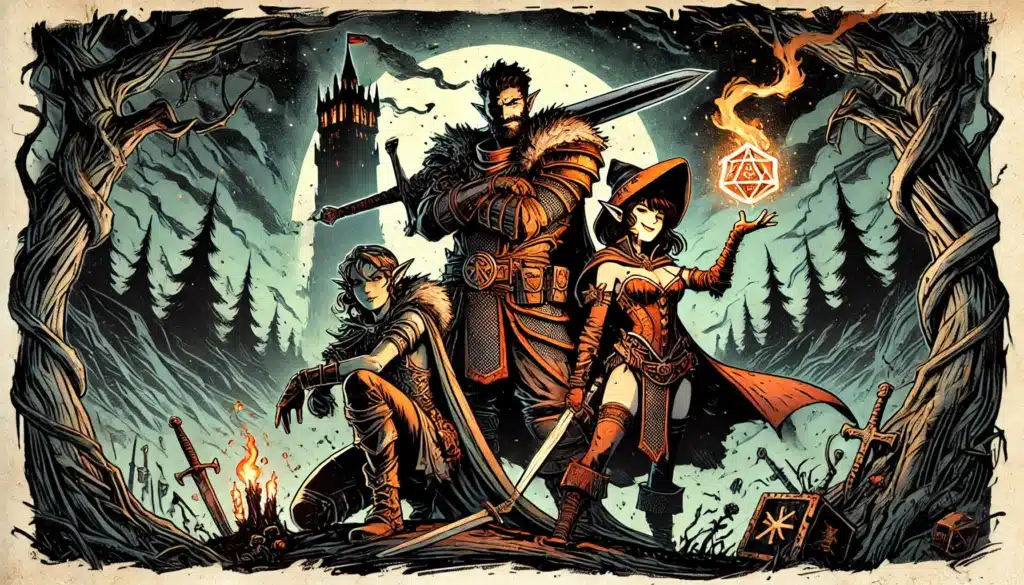
Aligning Character Backgrounds for Roleplaying Cohesion
As the tapestry of your D&D campaign unfolds, the personal stories of each character in your party weave together to form a rich narrative. But here’s a crucial tip: a well-aligned backstory can transform mere party members into a band of brothers (or sisters, or non-binary siblings). When character backgrounds mesh harmoniously, the roleplaying feels natural, and interactions flow with the ease of a bard’s melody.
When crafting your backstories, strive to avoid those awkward “stranger danger” vibes. The aim is to cultivate connections that elicit believable reasons to join forces. Nobody wants to roleplay that awkward first date vibe when two characters meet for the first time!
Sewing the strands of backstories doesn’t just make roleplaying smoother, it flavors the campaign with depth, paving the way for personal quests and dynamic inter-character drama. What’s even cooler? Those intricate backstory links make for epic narrative turns when plotlines circle back to character legacies.
Consider interweaving character origins using these methods:
- Shared Goals or Missions: Perhaps your party is a band of mercenaries united under a single lucrative contract, or maybe they’re scholars on a joint mission to recover an ancient artifact.
- Personal Connections: Brothers in arms, childhood friends, or even star-crossed lovers add personal stakes. Bonds like these make your character relationships much tastier—like an adventurer’s daily stew with a pinch of spice!
- A Common Enemy: United by a singular hatred—a foul villain who’s wronged each of them in different, diabolical ways—your group bands together to bring this nemesis to account.
Such rich connections allow players to springboard solidly into play, diving straightforward into shared adventures and facing challenges side by side. Now every victory holds deeper significance as each character fights not just for glory, but for friendship, honor, or personal satisfaction.
| Party Backstory Idea | Benefits | How It Enhances Roleplay |
|---|---|---|
| Mercenaries on a contract | Shared objectives unify goals | Turns mundane jobs into epic quests |
| Childhood friends | Natural banter and rapport | Smooth, genuine character dynamics |
| Former rivals | Tensions spark excitement | Opportunities for growth and trust |
| Sleeper agents | Deception thrilling plotlines | Subterfuge leads to dramatic twists |
| Fateful rescuers | Bonds strengthen over time | Heroic tales of selfless acts |
| Rogues gone straight | Challenges past resolve | Showcases character development |
| Exiled royalty | One seeks honor, the throne | Adds political intrigue elements |
| Different walks, one path | Varied skillsets, focuses | All roads lead to shared vision |
| Prison escapees | Common foes pursue the party | On the run narrative drives action |
| War comrades | Camaraderie enriches strategy | Shared experiences enhance loyalty |
A well-connected party elevates storytelling with believable reasonings cementing your team, making alliances logical and character motives transparent. The result? More immersive, emotionally resonant gaming that keeps players invested till the credits roll.

Avoiding Common Pitfalls in Party Building
Even adventurers must beware of traps beyond goblin snares and shadowy dungeons—like the common pitfalls of party composition! While excitement for a campaign can cloud prudent planning, rushing the foundational elements often leads to a rocky road. And no one desires a road paved with unwarranted tumbles and stumbles, right?
When a party lacks variety, they trip over challenges like toddlers on a tightrope. Too heavily weighted in one direction, and they’ll either crumble or trip at hurdles they never saw coming. That said, here’s a somewhat cheeky rundown on dodging these “oopsie” moments:
Firstly, when the party is all about blasting through foes like a meteor shower, problems arise—what happens when the party needs subtlety over showmanship? An all-glass-cannon party might cause epic damage but would be equally frail as glass chandeliers under ogre fists. If adversaries or traps gear diverse, inflexible skills risk faltering, forcing adventurers to pray they hit fast and first.
But lean hard into tanks, and you’ll watch the party squash enemies all day with no solutions for non-
“ת”ה misunderstandings or wordplay with nobles. Imagine your diplomatic endeavors handled solely by your armor-clad colossus—they might cause more stress than solutions!
Then there’re the pitfalls of a party with magical deer-sized gaps. Miss having a healer on board, and survival longevity becomes shaky. Long campaigns, fraught with snares and injuries, beg breaks requiring magical or mundane aid. Surviving becomes an ordeal unless inventive mixology or new plans are adopted!
Here are common party setup missteps to consider avoiding:
- All-glass cannon lineup.
- Too reliant on melee or physical attacks.
- The full-tank brigade.
- Crowd of disconnected soloists.
- Limited or no social abilities.
- No healers or support roles.
- Overabundance of identical classes.
- Over-reliance on ranged attacks.
- No one with magical utility.
- Focusing on only one game aspect (e.g., combat-only or only puzzles).
By steering clear of such blunders, players maximize their roles while expanding their horizons to untapped frontiers. A diversified party becomes a veritable juggernaut, conquering distractions, quests through dungeons, and social deceptions with aplomb.

Ideal Party Compositions for Different Group Sizes
Alright, adventurers, let’s get serious for a moment about the composition magic that turns a ragtag group into an adventuring powerhouse. Whether you’re charging bravely with a trio or coordinating a bustling mega-party of six or more, each setup demands its own strategic blend of skills and roles. Crafting the perfect party means ensuring that each character can support, enhance, and play off each other’s unique strengths, making even the fiercest dragon throws you an afterthought.
Below, find a series of tables tailored to the most common party sizes, each providing a robust setup to tackle sticky dungeon situations, knightly tales in far-off kingdoms, or the most beguiling puzzles your DM can conjure. Ready to optimize your adventure team?
Best Composition for 3 Player Groups
In a three-player lineup, versatility and synergy are key. Each member should cover several roles or skills to keep things running smoothly.
| Role | Suggested Classes | Key Advantages | Potential Challenges |
|---|---|---|---|
| Tank/Healer | Paladin or Cleric | Protective auras and healing spells | Multi-role pressure during intense battles |
| Striker | Rogue or Ranger | High damage output and stealth efficiency | Limited utility in magical encounters |
| Controller/Utility | Wizard or Druid | Spell versatility for control and utility | Limited physical resilience |
Best Composition for 4 Player Groups
A four-player group enjoys a balanced spread of abilities, making it possible to cover most essential roles while leaving room for specialized skills.
| Role | Suggested Classes | Key Advantages | Potential Challenges |
|---|---|---|---|
| Tank | Fighter or Barbarian | Sustains damage and controls the frontline | Vulnerable to magic-based attacks |
| Striker | Rogue or Monk | Decisive and stealthy attackers | Lesser ranged attack options |
| Healer/Support | Cleric or Bard | Healing magic and party buffs | Spread thin in larger, multi-front battles |
| Controller/Magic | Wizard or Sorcerer | Spell diversity and battlefield control | Limited melee capabilities |
Best Composition for 5 Player Groups
With five players, parties can enhance synergy, ensure balance, and include specialized roles or exotic combinations that thrive on teamwork.
| Role | Suggested Classes | Key Advantages | Potential Challenges |
|---|---|---|---|
| Tank | Paladin or Fighter | Defensive resilience, with some healing | May lack mobility in dynamic environments |
| Striker | Rogue or Ranger | High DPS and exploration skills | Susceptible to front-line damage |
| Healer | Cleric or Druid | Consistent healing and nature control | Can become primary target in tough battles |
| Controller | Wizard or Warlock | Effective crowd control and damage output | Resource management of spells |
| Utility/Support | Bard or Artificer | Integrates exploration and social skills | May lack direct combat power |
Best Composition for 6+ Player Groups
The grand adventure ensemble! Here, there’s room for creativity and overlap in roles, allowing for some radical and fun setups.
| Role | Suggested Classes | Key Advantages | Potential Challenges |
|---|---|---|---|
| Main Tank | Fighter or Paladin | High durability and protection spells | None; ideal in large battles |
| Off-Tank | Barbarian or Monk | Agile and can soak damage temporarily | May be stretched over multiple enemies |
| DPS Striker | Rogue, Ranger, or Sorcerer | High damage potential, both melee and ranged | Needs protection in combat |
| Healer/Main Support | Cleric or Bard | Streamlines party recovery and buffs | Core target; needs continuous protection |
| Secondary Support | Druid or Artificer | Complementary control, healing, or utility | Spreading support across party |
| Crowd Control | Wizard or Warlock | Immobilizes and handles groups effectively | Requires significant spell slots to be effective |
With these guides in hand, you’re set to craft a party that not only rolls through battles with ease but enriches the collective story with flavors only a well-rounded team can provide. So go forth, intrepid adventurers, and forge paths where heroes and legends await to be written with every roll of the dice!
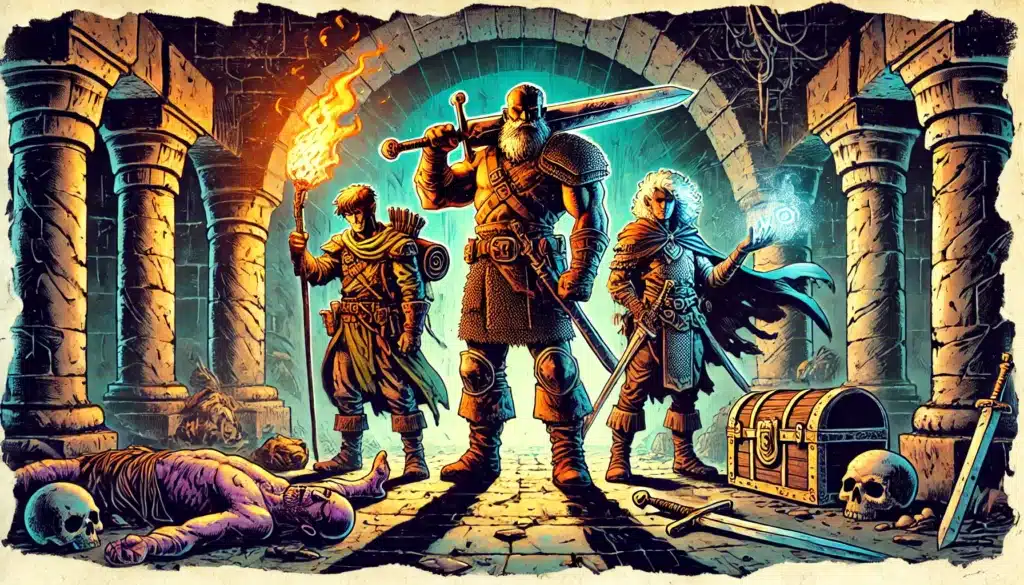
Final Thoughts on Party Balance in D&D
Ah, the wisdom of party balance, the sacred scroll by which all great adventures find their inspiration. Here, we’ve dug deep into the secrets of assembling a team that tackles timestream flops like time spent chugging ale at the tavern. A balanced party—what could be more glorious than all elements of D&D coming together like the pieces of a cosmic puzzle?
It’s all about gathering adventurers who, by the synergy, mesh well together—a team as comfortable a fit as wizards in robes woven from storyteller tapestries and warriors in mail crafted by their village’s finest. This ethos extends far beyond mechanics, sweeping into heartlands of roleplaying amity and harmony like a master storyteller’s quill in hand.
⚔️ Fantasy RPG Random Tables Books
Make life as a Gamemaster easier…
If you play Dungeons & Dragons, Pathfinder, or other fantasy RPGs, this
RPG random tables series
is packed with encounters, NPCs, treasure, and more. Available in eBook or print—either way, you’ll have a wealth of adventure ideas at your fingertips.
Congratulations! With just the right touch, you now wield those skills to forge legendary characters with relatable backstories! Balance within the party extends beyond practical combat and creative skill usage—it’s an orchestra of empathy, imagination, and RPG wizardry galvanizing unforgettable narratives!
Best parties realize that D&D doesn’t knuckle down purely on mechanics; that rightly contained kernel transcends through role-playing cohesion and exhilarating teamwork. Each member of a diverse party yields space for another’s sparkle, rewarding exploration, and cohesive story-weaving.
An ace campaign features experimentation, triumphs, and perhaps even kindling friendships along the dusty dungeon corridors. Branch out. Explore. Experiment with different compositions as your story unfolds, and let each player gleam within the grand scheme to situate tales like sparkling stars under the everlasting night sky!
Remember, D&D is about weaving unforgettable stories, depicting entrenchments amongst fortitude, friendships, and fables. Each adventure is meant to be exhilarating—building your dream team facilitates this magic play in the largest board game called life. So breathe life into dicey forays, embrace diversity, and GO CRAFT LEGENDS! From epic battles to heartfelt roleplaying moments, every session holds the potential for legendary tales. Understanding how to create D&D encounters that challenge and inspire players elevates the storytelling experience, making each decision feel impactful. So, gather your party, shape your world, and let imagination be the only limit to the adventures ahead!

